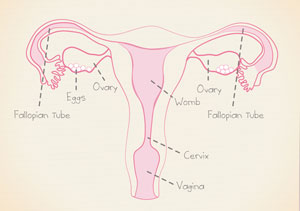Getting to know
your reproductive
system inside and
out! Part 2
#ovaries, #uterus , #vagina
From the time you were born your reproductive organs have been fully formed. However, they stay inactive (like being asleep) with very little change until a girl is around 10 years old. Around that age, little chemicals called hormones are sent by the brain to the reproductive system, letting it know that it’s time to ‘wake-up’ and start maturing, in preparation for one day when a woman might want to have a baby. Here’s what you need to know about your internal reproductive system:

VAGINA
- You can see the entrance to your vagina if you take a mirror and look between your legs.
- Did you know that by the time you reach puberty this part of your body (shaped a little bit like a tube) will start to increase in length and when fully grown will be anything from 6-12cm long?
- The inside of your vagina is not as smooth as you may think too. It can almost feel a little spongy with ridges and an elastic structure.
CERVIX
- Your vagina is linked to the uterus by your cervix. Think of this as a little bit like a canal linking one part of your body (the vagina) to your uterus and is no more than 2-3cm long.
- The opening to the cervix is no larger than the head of a matchstick. Many girls are worried that if they use a tampon, it will travel up inside their body but there is no way a tampon could get lost from the vagina as the entrance to the cervix is so small.
- The cervix also has a big part to play in fertilisation. For an ovum (egg) to be fertilised by a male’s sperm, it will need to travel through the cervix to reach the rest of your reproductive organs.
- This part of your body is very clever too and, when needed, will open to allow a baby to pass through, only to close up again afterwards.
UTERUS
- The uterus is sometimes called the womb and has one of the most important roles to play in your reproductive system.
- It’s shaped a little bit like a pear and when fully developed will be about 7.5cm long.
- This is where a baby would grow if an egg had been fertilised and where your menstrual fluid is found.
- It is surrounded by some of the strongest muscles in a female’s body and it is these muscles that can help push a baby out when it is ready to be born. For females who have periods, it is these muscles that contract to allow menstrual fluid to leave the body and can sometimes be responsible for period cramps too.
FALLOPIAN TUBES
- These are two very fine tubes that lead from the ovaries and into the uterus. They are about 10cm long and have at one end a section that looks like a ‘frilly skirt’. This section is situated very close to the ovary, so when an egg is released it can catch it.
- It is inside the fallopian tube, that as the egg travels down it to the uterus, that fertilisation can take place.
OVARIES
- Just like the fallopian tubes, you have two ovaries and even before you were born they will have stored all the eggs you needed to make a baby…more than a million!
- Your ovaries are oval in shape and about 4-5cm long. They hold within them ovum (eggs) that if fertilised could make a baby. Those little chemicals called hormones tell the ova (egg) when to mature and get ready for release.
- During your menstrual life you will release approximately 400 ova and even though they are very small, they are visible with the naked eye.
- Generally the ovaries take it in turn from month to month to release an egg.
GETTING TO KNOW
YOUR REPRODUCTIVE
SYSTEM INSIDE AND
OUT! PART 1